
Issue Contents

Photo Essay: Rebuilding Bhaktapur, Nepal
It has now been just over one year since the magnitude 7.8 earthquake struck central Nepal. Bhaktapur turns out to have been one of the worst-hit areas. In the immediate aftermath of the earthquake, it was not yet apparent just how serious the damage was, and many buildings that seemed to have survived intact will in fact have to be demolished and reconstructed. About 75% of the building stock requires replacement.
The earthquake was followed by a five-month blockade of Nepal's border with India. Everything was in short supply during this period including fuel and building materials. Despite a promise of over $4 billion in reconstruction aid from foreign donors, almost none of it has reached the affected citizens as of press time. Despite this, locals are beginning the rebuilding process, even though the pace is still slow, with only a comparatively small number of buildings now under construction. In many cases, an existing building must first be demolished before foundation work on the new building can begin.
In the past few days, Ram Kumar KC, our resident photographer, walked through most of Bhaktapur and photographed the works in progress. You will note that most new construction employs reinforced concrete for the pillars, beams, and floors. Buildings of this type generally survived the earthquake intact except for some cases where the foundations were inadequate or the structural elements were undersized. It is to be hoped that the new Bhaktapur will survive the next earthquake without serious damage.
So far, most of the new construction seems to respect, at least to a degree, the architectural traditions of Bhaktapur in particular and Newari cities in general. The urge to widen streets was fortunately resisted, so Bhaktapur will remain a walking city, notwithstanding the rapid increase in motorcycle ownership. Soon, there will be so many that there will not be space enough to ride or park in the city. At that point, something will have to be done to curb traffic.
Click on any image to open a bigger version in a new tab. Ctrl+w will close the new tab and return you to Carfree Times.
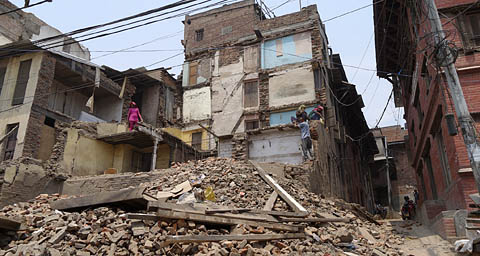
Not all of the demolition work was completed last year.

2016 Ram Kumar KC
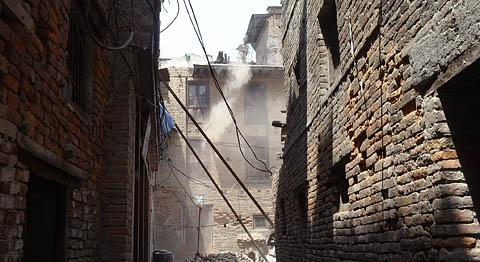
As always, demolition is dirty, noisy, and dangerous.

2016 Ram Kumar KC
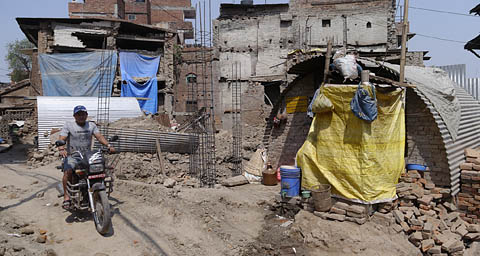
Zinc-plated sheeting was used to construct many temporary shelters.

2016 Ram Kumar KC
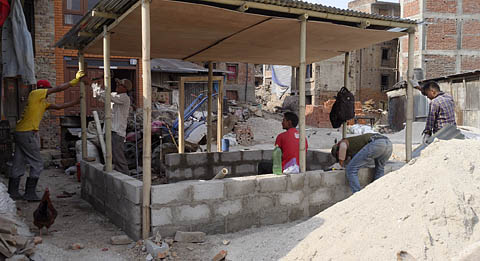
Some temporary shelters are still being built this spring.
People are anticipating a long wait for permanent buildings.

2016 Ram Kumar KC
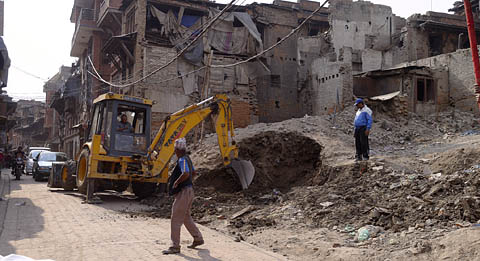
Heavy earthmoving equipment is rather rare in Nepal.

2016 Ram Kumar KC
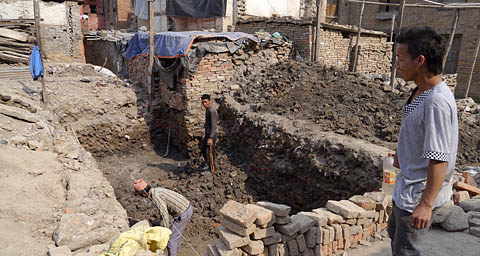
Most foundation work is still done by hand.

2016 Ram Kumar KC
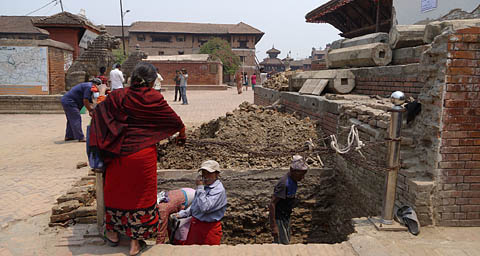
This is where Durbar Square's White Gate once stood.

2016 Ram Kumar KC

In South Asia, nearly all reinforcing bar is bent in half for shipping.
Straightening the bar makes a lot of extra work.

2016 Ram Kumar KC
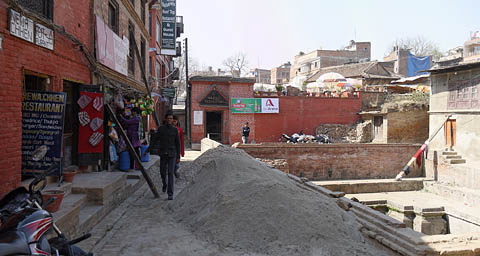
Piles of aggregate can now be found all over Bhaktapur.

2016 Ram Kumar KC

Quite a few bricks from old buildings will be reused.

2016 Ram Kumar KC
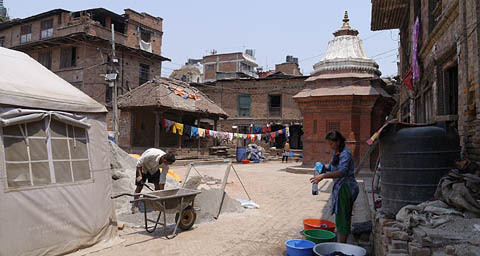
Screening of aggregate is done by hand.

2016 Ram Kumar KC

Small batches of mortar are mixed by hand.

2016 Ram Kumar KC
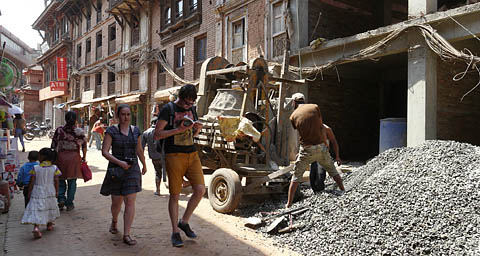
Medium-sized concrete mixers are used when pouring heavy work.

2016 Ram Kumar KC

Inadequate foundations were a major cause of building collapses.
It appears that the new work is being done more carefully.

2016 Ram Kumar KC
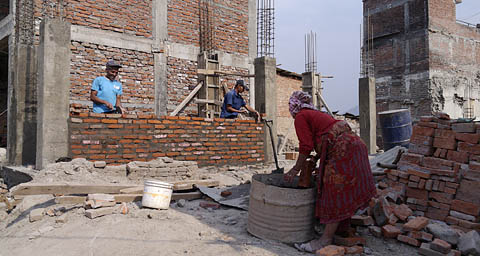
In the new buildings, the bricks are usually non-structural.

2016 Ram Kumar KC
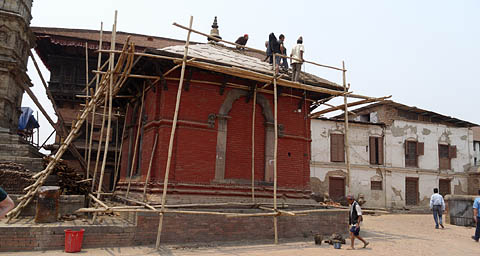
This temple needed a new roof.

2016 Ram Kumar KC

This temple, however, required reconstruction.
Bhaktapur lost comparatively few major temples,
probably because of German renovation work in the 1970s.

2016 Ram Kumar KC
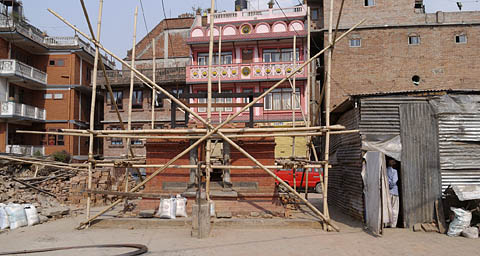
A new, small temple rises from the ground.

2016 Ram Kumar KC
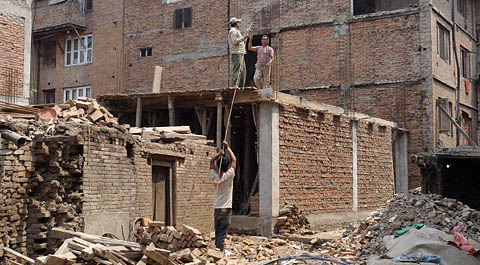
Work is slowed by the need to allow one story's concrete to cure before continuing.

2016 Ram Kumar KC

Many new buildings echo the traditional styles, often imperfectly.

2016 Ram Kumar KC

Before the earthquake, most buildings were about four stories tall.
New buildings may only be built in stages but
will probably reach four stories eventually.

2016 Ram Kumar KC

|

|

Announcements
Film Status Update:
Recovering from Disruption: A Comprehensive Approach to Building a Better, More Sustainable World
This 54-minute film was released last summer. It proposes solutions to the many challenges to achieving a sustainable society. The rate of views is climbing slowly and is approaching the 10,000 mark.
The film can be viewed or downloaded online for free. It may be shown to anyone as long as no admission fee is charged. The film is available at:
Vimeo (recommended, version 1.005)
YouTube (works better for some users, original release version)
You can also use the Carfree channel at Vimeo, which gives access to another 30 videos on carfree cities and related issues.
The Books
Carfree Cities and Carfree Design Manual are widely available from booksellers in Europe and North America.

News from Our Friends
Our colleagues at Work for a Better Bangladesh (WBB) in Dhaka have recently established the Institute of Wellbeing. The objective of the new organization is to facilitate the exchange of ideas and information on ways to increase wellbeing. (WBB is our partner in the film "Recovering from Disruption.")
Carfree.com supports World Carfree Network (WCN). Alas, due to lack of funds, WCN has been inactive for several years now.
Some of the earliest promoters of the carfree idea later founded the degrowth movement. The 5th International Degrowth Conference will be held in Budapest from 30 August to 3 September.

Editorials
The Emergency Has Arrived
By J.H. Crawford
The News Bits section below makes it clear that the long-dreaded climate emergency has now arrived. Temperatures are soaring, ice is melting, forests are burning, and there is no clear end in sight. CO2 in the atmosphere is actually increasing at a record rate despite some timid efforts to slow it down. The Paris COP21 talks last year set the goal of limiting warming to 1.5°C, which, it appears, we have almost reached (see Climate Change in News Bits), years before it had been generally predicted to arrive.
I don't like the term "war on ....", but we do now need a global effort to halt climate change on an emergency basis. Nothing that is on the table now will achieve that goal; we must make much more serious commitments, and act upon them immediately. I can think of no better approach than that which we proposed in our film, Recovering from Disruption, mentioned just above. We will need major changes in just about every aspect of society as we know it. Fortunately, many of these changes can actually lead to a better life for everyone except maybe the richest 1%, who are largely responsible for the mess we are in.
Perhaps the most shocking News Bit is the one showing that environmental causes are an important factor in 25% of all human deaths worldwide. But it gets even worse, because the environmental disaster is affecting virtually all life on the planet, which in turn affects the capacity of the Earth to continue to provide a home for us all.
It's too early to know for sure, but all the signs point to our having arrived at the climate tipping point. The huge increase in atmospheric methane is extremely scary. It may be the harbinger of runaway warming, as methane is a very potent greenhouse gas, and it is expected to be released more quickly as the climate warms.
The time to leave fossil fuels in the ground is right now. A large carbon tax, preferably enacted unilaterally by each nation as fast as it can, is almost essential. I can think of no other measure that will achieve the necessary reduction in emissions of CO2 and methane. The building of fossil fuel infrastructure continues despite the fact that energy from renewable sources is becoming cheaper than from fossil sources even before the costs of greenhouse gas emissions are added. Still, market mechanisms will not achieve change fast enough to solve this crisis.
I used to think that the climate crisis was an academic matter for me personally - I would be long dead and gone before the worst hit. Sitting here in Bhaktapur, I am no longer so sure. Every night I see the red glow of forest fires on the mountains to our south. The air is dirtier than it was just two years ago, when I moved here. The extended drought in South Asia has caused the fires, and it has also caused a severe water shortage. The rate at which Arctic sea ice is vanishing is almost unbelievable.
So, these days, I wonder if the climate is going to kill me after all. If it doesn't get me, it will certainly get people I care about who are younger than me. It's time to prepare yourself for major changes, sooner or later. The major changes we make sooner will be, I promise you, far more palatable than the major changes that nature will soon force upon us.
Act!
Technology Not to the Rescue
By J.H. Crawford
The news is all full of electric cars and robotic cars, and cars, cars, cars. Only the Guardian has dared to question how this all plays out.
Safe, self-driving, electric cars only solve a small fraction of the problems that cars cause. Let us assume for the sake of argument that we can produce the needed billion or so self-driving electric cars. (This assumption is by no means warranted, given limitations in material resources, energy, and financing.)
So, supposing that we build the necessary fleet of robotic cars and find enough energy to recharge them, what problems have we actually solved by this measure? Yes, perhaps the energy and pollution problems have been fixed, and maybe the safety issues with cars as well.
What unsolved problems does this leave? Well, it's a long laundry list. Cars will always take up too much of the precious land in cities. They will always make too much noise at high speed. They will always be an ugly blot on what should be the beautiful faces of our cities. They are inherently isolating and lead to weaker social bonds. Even if they are perfectly clean and are never involved in collisions, they are still a public health menace, as they discourage people from walking and cycling and so lead to increased death rates from a long list of causes.
Their presence in large numbers will continue to depress real estate values near highways. They will continue to consume immense amounts of money for their construction, operation, and scrapping. The public will continue to subsidize the construction and maintenance of highways. These highways will continue to form barriers that divide communities.
As I said 16 years ago in Carfree Cities, the car "will remain the most expensive, most resource intensive, and least sustainable method of urban transport." The passage of time and the advancement of technology has only served to strengthen my conviction that cars just don't belong in cities.

News Bits
The links below will open in a new browser window or tab, depending on your browser; (Ctrl+click) may behave differently:
Urban Planning and Design
"Redesigning our cities"
Our Dristy Shrestha recently published an article in the local English-language newspaper Kathmandu Post. She suggests that traditional Newari cities in Nepal are actually a livable and highly sustainable arrangement that might well be replicated far more widely than just in Nepal. (KathmanduPost.EKantipur.com)
"Jane Jacobs Was Put to the Test in 6 Italian Cities"
"Our results suggest that Jacobs's four conditions for maintaining a vital urban life hold for Italian cities," concludes the report. "Active Italian districts have dense concentrations of office workers, third places at walking distance, small streets, and historical buildings." Dear old Jane did get some things wrong, but she certainly was right about the stuff that matters. (NextCity.org)
"Bike, pedestrian-friendly cities are worth the fight says former NYC transport planner"
"... according to Janette Sadik-Khan, who, during her time as transportation commissioner for New York, built more than 600 kilometres of new bike lanes, and repurposed 180 acres of asphalt for pedestrian and bike use." She's our hero! (CBC.ca)
Climate Change
"Washington State Kids Score Huge Legal Win In Climate Change Lawsuit"
"A judge’s ruling on Friday in a lawsuit filed by eight kids forces the state of Washington to get dead-serious about the threat of climate change." A huge victory for the kids who are, after all, going to have to live with this mess. (HuffingtonPost.com)
"Judge Denies Motions by Fossil Fuel Industry and Federal Government in Landmark Climate Change Case"
"These plaintiffs sued the federal government for violating their constitutional rights to life, liberty and property, and their right to essential public trust resources, by permitting, encouraging and otherwise enabling continued exploitation, production and combustion of fossil fuels." It's so gratifying to see the current generation of young people getting angry about the mess we're going to leave them to deal with. They are taking effective action, and I think this is only the beginning. (EcoWatch.com)

Global land and ocean temperature anomalies, January-December.

2016 NOAA
"Record leap in carbon dioxide seen in 2015"
In 2015, atmospheric CO2 saw the largest year-on-year increase in the 56 years on record. Our efforts to tackle climate change are clearly not working. (phys.org)
"Humans and El Niño Team Up to Create a Record Jump in CO2 Pollution"
"Remember 2016 - it is the infamous year that has already recorded the largest annual change on record in the makeup of the air you breathe. Fueled by people's pyromania and the El Niño global weather phenomenon, carbon dioxide concentrations reached 409.44 parts per million on April 9 at an air-sampling station atop Hawaii's Mauna Loa, a rise of more than five ppm since the same date last year. And it could get worse." (ScientificAmerican.com)
"Why is 2016 smashing heat records?"
This year is already insanely hot, with records falling everywhere. Temperatures rose to near freezing at the North Pole in late December. That is 30-35°C warmer than normal. [Arctic sea ice has trended at record lows all winter and now into the spring; we may see the 2012 record low sea ice extent beaten.] (TheGuardian.com)
"February breaks global temperature records by 'shocking' amount"
"The NASA data shows the average global surface temperature in February was 1.35°C warmer than the average temperature for the month between 1951-1980, a far bigger margin than ever seen before. The previous record, set just one month earlier in January, was 1.15°C above the long-term average for that month." (TheGuardian.com)
"NOAA: Monthly Temperature Reports Are 'Sounding Like A Broken Record'"
"Last month was the hottest March on record by far, NOAA confirmed Tuesday. March was 2.2°F above the 20th century average. This anomaly was 'the highest monthly temperature departure among all months' in the 1880-2016 record." (ThinkProgress.org)
"Scientists beat the alarm: Levels of methane increasing rapidly in the Arctic"
Methane levels in the Arctic are rising rapidly. This is an especially alarming development, as methane is a potent greenhouse gas. The concern is further amplified by the known methane sinks in the Arctic which may release large amounts of the gas into the atmosphere once some as-yet unknown warming threshold is reached. We may already have passed that threshold, in which case all projections of climate change can be tossed out. (TheBarentsObserver.com)
"Global warming may be far worse than thought, cloud analysis suggests"
"Climate change projections have vastly underestimated the role that clouds play, meaning future warming could be far worse than is currently projected, according to new research. Researchers said that a doubling of carbon dioxide in the Earth's atmosphere compared with pre-industrial times could result in a global temperature increase of up to 5.3°C - far warmer than the 4.6°C older models predict." (TheGuardian.com)
"Antarctic ice melt could drive sea levels up twice as high as we thought"
"In a new study, a pair of climate scientists say an accurate estimate of sea-level rise is actually double that of previous predictions." (CSMonitor.com)
Transport, Pollution, etc.
"Fossil fuels could be phased out worldwide in a decade, says new study"
"The worldwide reliance on burning fossil fuels to create energy could be phased out in a decade, according to an article published by a major energy think tank." This is the kind of visionary thinking that is needed to tackle the climate crisis. (ScienceDaily.com)
"In a World Made Toxic, Nearly a Quarter of All Human Deaths Caused by Pollution"
"The report, which surveyed global causes of deaths in 2012, found that a startling 12.6 million deaths that year could be attributed to toxic environments. The causes ranged from air, water, and soil contamination to climate change." This is a simply shocking number. I think we can anticipate a decline in life expectancy for the first time in centuries. (CommonDreams.org)
"We don't need self-driving cars - we need to ditch our vehicles entirely"
The good old Guardian nails it again. (TheGuardian.com)
"Nearly all US forests threatened by drought, climate change"
A large research study has shown that US forests are already under threat from changing climate. In fact, not very much is known about how forests will respond to climate change, but drought is already causing significant damage. (Eurekalert.org)
"Cuba's sustainable agriculture at risk in U.S. thaw"
Out of necessity rather than choice, Cuba converted to highly sustainable farming in the early 1990s. The loss of income when the USSR broke up forced sudden and dramatic reductions in Cuba's energy consumption, including farming. The changes were accompanied by an actual increase in production. Now that the USA and Cuba are once again on good terms, Cuba's advances in agriculture may come under threat from US practices. It would be a great loss to knowledge and practice regarding sustainable agriculture if this comes to pass. (Resilience.org)
"Plants boost extreme temperatures by 5°C"
"Heatwaves from Europe to China are likely to be more intense and result in maximum temperatures that are 3~5°C warmer than previously estimated by the middle of the century - all because of the way plants on the ground respond to carbon dioxide in the atmosphere." Another unwelcome and unexpected consequence of greenhouse gas emissions. (ScienceDaily.com)
"Eemshavencentrale Nuon wordt 'superbatterij' voor zon- en windenergie"
An existing gas-fired power plant in the Netherlands will be converted to run on ammonia produced from air and water using surplus energy from sustainable sources. The ammonia is burned in existing gas turbines. Efficiency is only 40~45%, but this is energy that would otherwise have been wasted. This is apparently the first application of the technology on a large scale. If successful, it would go a long way to evening out the peaks in sustainable energy production. (NOS.nl)
"Volvo sells electric bus system to Namur in Belgium"
Volvo has sold a turnkey hybrid bus system to Namur. This is a small order, only 11 buses, but Volvo is sure enough of its technology that it is undertaking to keep the fleet running for a fixed monthly cost. These buses do have small diesel engines, but apparently they are not expected to be used very much. Battery technology continues to advance, and all-electric battery-powered buses are in fact already available, although their range is still limited. (LinkedIn.com)

About Carfree Times
Next Issue
The next issue of Carfree Times is scheduled for August/September 2016.
Subscribe to Carfree Times
Carfree Times is published quarterly at Carfree.com.
To receive e-mail notices of new issues, please visit the subscription page or
send e-mail with the word "Subscribe" in the subject line. We do not share our mailing list.
Write for Carfree Times
Interested in writing for Carfree Times? We welcome articles on a wide variety of subjects and offer an opportunity to publish letters to the editor and guest editorials. Drop us an e-mail.

Back to Carfree.com
Carfree Times Home
Back to Carfree Times Issue 81
Forward to Carfree Times Issue 83
E-mail
carfree.com
Text and illustrations, except for guest content, placed in the public domain

|

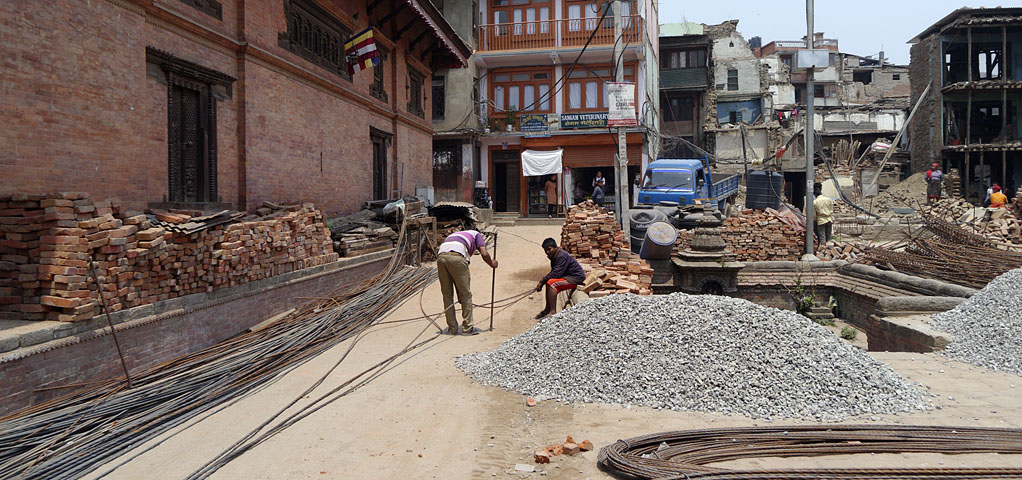





















![]()
